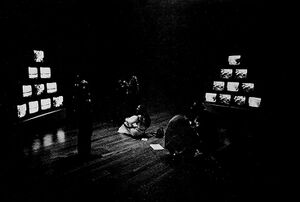Talk:Double Bind's Double life
August 2021
Double Bind's Double Life
I ADDED THIS
Sol: To which page? oh. Never mind, I found it. going to quickly go through and check typos and flow, then jump back to Double Binds Double Life
[...] and Dan Graham’s TV Camera/ Monitor Performance (1971)Graham, holding a portable video camera wired to a monitor, rolls backwards and forwards on a raised platform. An audience watches Graham in front of them and the monitor tot heir right. Graham: “As I roll, my goal is to, as much of the time as possible, have the camera's view oriented at the monitor image. When the camera is successfully aimed, the result is a patterno nthe monitor of image-within-image- within-image-feedback.[1]; Frank Gillette’s, Video: Process and Meta-Process (1973) An exhibition including nine separate but interactive "information environments". These included Tetragrammaton, an arrangement of 30 TV monitors. Gillette: "The piece is designed to immerse the audience in the processes of nature and thus surrounds the viewer with a video ecology of oceans, forests, ponds, insect life, birds, clouds and lakes. A single audio track of natural sounds unifies the work." [2].

https://www.frankgillette.com/process-and-meta-process-1
Morning Steve. I have some meetings today, so I will have to break time up into one or two hour blocks through the day.
OK, so the meeting that was scheduled for in five minutes just got postponed for 2 months. thats annoying but being out of that Loop means I am happily in this Floop for a solid 4 hour block now, as the following one also got postponed to Monday. :)
Is this formatting yours or the original?
They are playing a game
They are playing at not playing a game.
If I show them I see they are I
shall break the rules and they will punish me.
I must play their game of not seeing I see the game.
R.D Laing Knots I (1970) [1]
Sorry, this is the spacing in the original:
They are playing a game. They are playing at
not playing a game. If I show them I see they
are, I shall break the rules and they will
punish me.
I must play their game, of not seeing I see
the game.
Well spotted, because the spacing seems quite crucial to Laing. FIXED
Please add space : (1970) [1] I've found that where there is a space, often the reference ends up coming after a line break, I think it's best if there's no space generally, tho for aesthetic reasons can put one here. no risk.
ok :-)
I want to add an image to Fabulous L de L chapter. Do I have the all clear? I have the edit page open, but I can close and come back to it when you're done? it is closed now.
all clear
OK will be finished in a few minutes.
OK ALL CLEAR! cool, thanks. about to finish section one of double life, so will go back to what you've done in a couple minutes. thanks :)
please check this bit again:
👍 OK
I've gone through it, some typos, and tweaked the focus a bit so its on the work in each example (it kind of changed subject a bit between them, went with what was established din the first. It's good to have the additions you have made.
If the Portapak as a piece of technology encouraged a radical new form of social-media and media collectivity, it also allowed for the creation of artworks which made the individual's place within a media circuitry visible. Paul Ryan’s Everyman’s Mobius Strip (1969) was a video confessional, a private feedback booth, where one could record oneself going through a series of simple exercises and view the playback privately before the tape was erased; Frank Gillette and Ira Scheider’s Wipe Cycle(1968), a grid of nine monitors displaying broadcast images, prerecorded tapes and timed tape-delay images of the audience in front of the monitors;[55] and Dan Graham’s TV Camera/ Monitor Performance (1971)Graham, holding a portable video camera wired to a monitor, rolls backwards and forwards on a raised platform. An audience watches Graham in front of them and the monitor tot heir right. Graham: “As I roll, my goal is to, as much of the time as possible, have the camera's view oriented at the monitor image. When the camera is successfully aimed, the result is a patterno nthe monitor of image-within-image- within-image-feedback.[56]; Frank Gillette’s, Video: Process and Meta-Process (1973) An exhibition including nine separate but interactive "information environments". These included Tetragrammaton, an arrangement of 30 TV monitors. Gillette: "The piece is designed to immerse the audience in the processes of nature and thus surrounds the viewer with a video ecology of oceans, forests, ponds, insect life, birds, clouds and lakes. A single audio track of natural sounds unifies the work." [57].